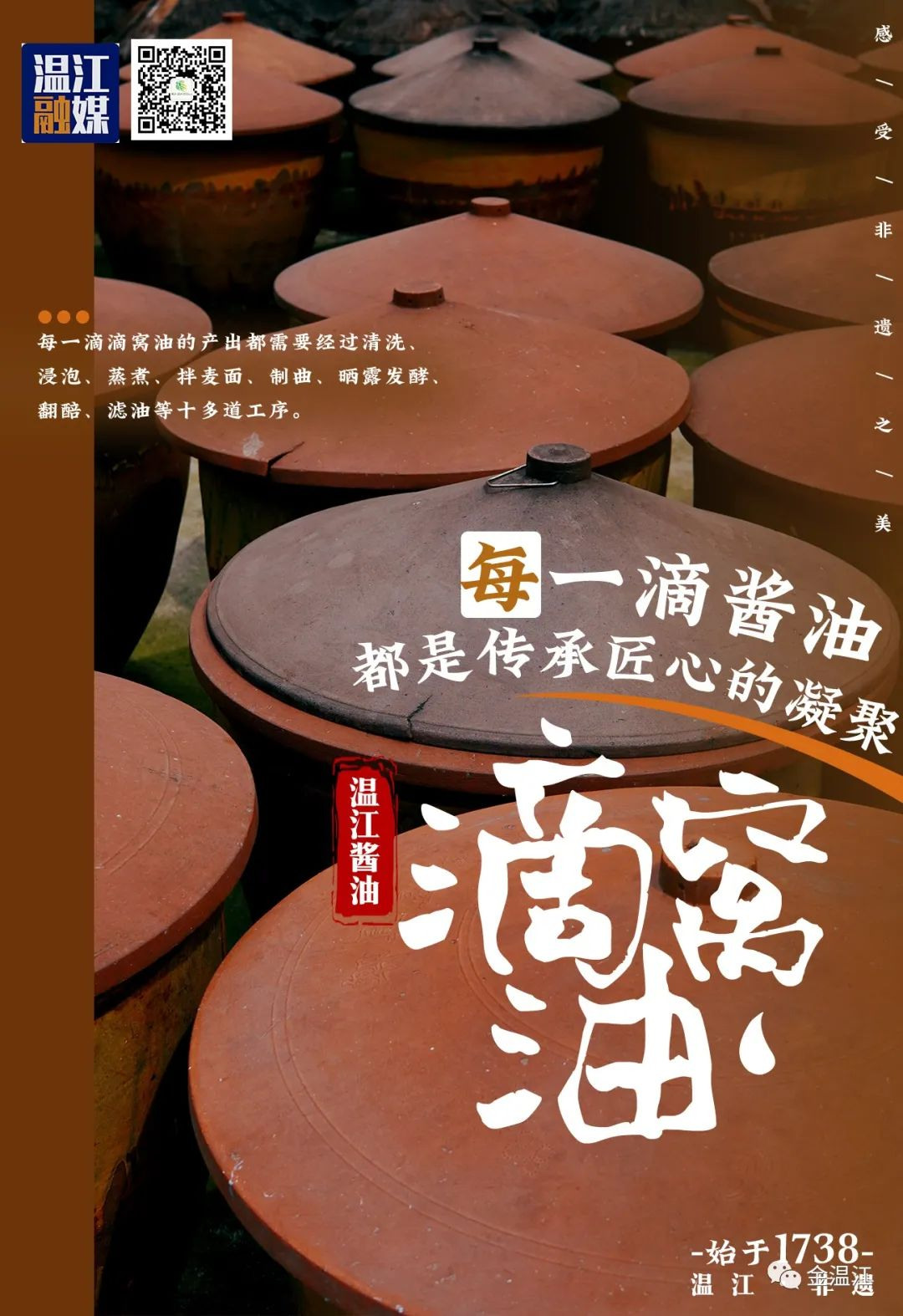[Wenjiang Flavor] A Bite of Wenjiang Intangible Cultural Heritage〔温江味道〕舌尖上的温江非遗


Intangible cultural heritage is
an integral part of excellent
traditional culture, a
crystallization of the wisdom
of the Chinese nation, and the
treasure of human civilization.
Boasting nine intangible cultural
heritage projects of traditional
handicrafts up to now, including
four at the municipal level and
five at the district level, Wenjiang
District has developed various
intangible cultural heritage
products such as Wenjiang Fei'er
Powder, Wenjiang crunchy candy,
and Wenjiang soy sauce.
非物质文化遗产是优秀传统文化的重要组成部分,是民族智慧的结晶,人类文明的瑰宝。截至目前,温江已有9项传统手工制作技艺类非遗项目,其中市级4项、区级5项,并形成了温江肥儿粉、温江酥糖、温江滴窝油等品类丰富的非遗产品。

The Wenjiang crunchy candy, invented by
Ma Jingshan and his brother Ma Zhuoyun
in Shou'an Township, Wenjiang County
(now Wenjiang District) in the 24th year
of Emperor Guangxu's reign in the Qing
Dynasty (1898), is a representative of
handmade candies in Wenjiang District.
In 2008, the craftsmanship of making
Wenjiang crunchy candy was included in
the list of municipal intangible cultural
heritage projects in Chengdu. Adopting
the traditional recipe, the Wenjiang
crunchy candy is made with white sesame
seeds, refined sugar, processed glutinous
rice flour, cooked maltose, and freshly
pressed rapeseed oil. First, wash, peel,
and fry the white sesame seeds that are
full-grain and bright until they become
crispy. Second, add sugar for grinding,
repeatedly sieving, and keeping warm.
Third, mix sugar, maltose, rapeseed oil,
clear water and other ingredients in
proportion and boil them until the mixture
can be pulled into continuous threads while
it is hung on the wall. Forth, fix the mixture
on a special iron pole for pulling candy and
manually pull and stretch it repeatedly until
the mixture turns white. After cooling the
white mixture, knock down a certain
amount of sugar blocks and boil them into
syrup. Fifth, spread the syrup evenly on a
chopping board, roll it into thin slices with
a rolling pin, and fold it with sesame flour
repeatedly for dozens of times to create a
layered shape like a steamed twisted roll.
Then, shape it with a special wooden
clamp. Finally, slice the well-shaped sugar
block and that's the crunchy candy. The
Wenjiang crunchy candy tastes delicate
and smooth, delectable but not cloying,
sweet but not overly sugary, crispy but
won't make you thirsty, and crunchy but
not too hard.
温江酥糖,起源于清光绪二十四年,为温江寿安马敬山、马卓运兄弟所发明,为温江纯手工制作糖果的代表。2008年,温江酥糖制作技艺被列入成都市市级非遗项目名录。温江酥糖采用传统配方以白芝麻、精白糖、糕粉、熟面饴糖、鲜榨菜籽油为配料,选用颗粒饱满、色彩鲜泽的白芝麻清洗、去皮、炒酥脆,加白糖进行碾细、反复筛、保温。将白糖、饴糖、菜油、清水等按比例混合后熬炼,熬至挂壁拉丝不断后,将其固定在专门拉糖的铁柱上,进行手工反复拉扯,直至糖呈白色状。在拉白冷却的糖块上,敲下一定量的糖块再次熬化,将熬化后的糖浆放在案板上摊开,用走锤将糖擀成薄片,和着芝麻面反复叠上几十下叠成花卷状,最后用木夹将其夹成一定形状。将木夹夹好的糖块切片,酥糖就做好啦。温江酥糖尝起来细腻化渣,香不腻人、甜不见糖、酥不顶口、脆不觉硬。


The traditional technique of making
Wenjiang Fei'er Powder originated in the
late Qing Dynasty and the early Republic
of China. In 2020, the traditional technique
of making Dundu Wenjiang Fei'er Powder
was rated as intangible cultural heritage
of Wenjiang District. Wenjiang Fei'er
Powder is made from dozens of high-
quality ingredients such as rice, soybeans,
coix seeds, Chinese yam, prickly waterlily
seeds, and chicken's gizzard skins, with 13
techniques adopted during the production
process, including frying, roasting,
toasting, simmering, drying, baking,
grinding, steaming, boiling, broiling,
milling, sanding, and clay baking. With
ingredient proportions adjusted based on
different groups' nutritional needs, it is
finally produced under the inspection of
famous experienced traditional Chinese
medicine practitioners. Specifically,
Wenjiang Fei'er Powder is made from
high-quality rice, soybeans, and other
homologous ingredients in food and
medicine mixed according to a seventy-
thirty ratio. This endows Wenjiang Fei'er
Powder with medicinal properties that take
effect through the power of food, thus
achieving a balance and regulation for
human bodies. Thanks to the combination
of this theory and the traditional technique,
the simple rice paste has been turned into
the Wenjiang Fei'er Powder, which is
smooth, nutritious, and full of different
ingredients.
温江肥儿粉传统制作技艺起源于清末民初,2020年,墩笃肥儿粉的传统制作技艺被评为温江区非物质文化遗产。温江肥儿粉选取优质大米、黄豆、薏苡仁、淮山、芡实、鸡内金等数十种食材,经由“炒、烧、烤、焖、烘、焙、磨、蒸、煮、炙、碾、沙、土”十三种制作技法,并根据不同人群的营养需求改变原料配比,通过名老中医层层把关制成。以优质大米和黄豆,配以食药同源的食材,按照三七比例将“食物赋以药用,而药用借饮食之力得以发挥,达到调理、平衡的作用”。这一理论结合传统制作技艺,才得以将单一的米糊,变成了口感顺滑、层次丰富具有极高营养价值的肥儿粉。


The Wenjiang soy sauce brewing technique
dates back to Emperor Qianlong's reign in
the Qing Dynasty (1736-1796). Wenjiang
soy sauce, inherited for 285 years, has
witnessed the "taste history" of generations
of Wenjiang people as a geographical
indication product of the Wenjiang District
in China. In 2009, the Wenjiang soy sauce
production technique was listed as
Chengdu's intangible cultural heritage.
Soak carefully selected soybeans and
wheat in water and steam them in a
traditional way before adding wheat
flour. Thoroughly stir the mixture and
leave it in the humid air to create
fermented koji mold. Put the mixture into
a sauce jar for exposure day and night for
8 to 12 months. To make sure it is fully
fermented, manual turning of the mixture
is necessary during the exposure and
fermentation. Then the soy sauce mash
comes into being through vigorous stirring
with traditional methods. Store the soy
sauce mash in a large wooden barrel when
it is fermented and turns dark reddish
brown with oozed-out sauce. Put a bamboo
basket in the sauce jar to separate the solid
residue from the liquid that will be
produced when the fully fermented soy
sauce mash is cooled. Scoop the liquid
from the basket and that's the Wenjiang
soy sauce. The refined Wenjiang soy sauce
is clear, bright, sticky, dark reddish brown
and nutritious, featuring a strong and
mellow aroma, fresh and delectable taste,
and rich texture and tasty flavor. In
addition, it can be stored for a long time
without deterioration and preservatives.
温江酱油的酿造时间可追溯到清代乾隆年间,至今传承了285年的滴窝油是温江数代人的“味觉历史”,同时也是温江的中国地理标志产品。2009年温江滴窝油酿造技艺被列为成都市非物质文化遗产。大豆和小麦经过精细筛选后,用清水浸泡、传统方式蒸煮后,再拌入麦面,充分搅拌,伴随湿润的空气完成发酵制曲。放入酱缸后需要日晒夜露历经8—12个月。为了保证发酵充分,在晒露发酵过程中必须进行人工翻酱,用老道的力度翻搅之后,制成酱胚。后期酱醅发酵呈深红棕色,还有部分酱汁渗出,就装入大木桶内贮存。在缸中放入竹笼,当成熟酱胚遇冷回润产生的汁液,将酱渣隔在笼外,从笼中舀取汁水即成滴窝油。成品滴窝油具有体态清亮,色泽鲜亮、挂壁性好、深红棕色的特征,同时营养丰富、酱香醇厚、色鲜味美、质浓味醇不含任何防腐剂,且久储不变。



来源 Source | 金温江
排版 Typesetting | 赵术君
审核校对 Senior Editor | 陈倩


评论